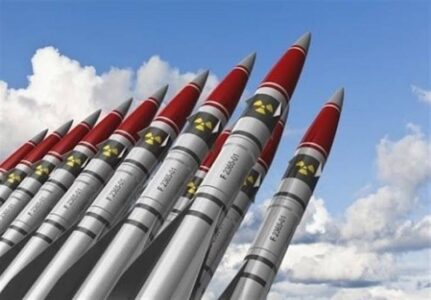
Iran brags about its missile export to Palestinians and Hezbollah
Iranian pro-government media published an article on Sunday bragging about its “integrated missile network” and how it has armed the “resistance” in the Middle East.
By “resistance,” the report was referring to a network of pro-Iranian groups and proxy groups it supports, particularly Hezbollah, the Palestinians and Yemen.
The article begins as a tribute to Hassan Tehrani Moghaddam, an Iranian IRGC general who was killed in an explosion at a missile facility near Tehran on November 12, 2011.
The report notes that “several IRGC officers were also martyred in the Moddares arsenal explosion along with Tehrani Moghaddam. At the time of his martyrdom, Tehrani Moghaddam was preparing a missile test.” The article notes that he was a key figure in the missile program for years, often considered the “father” of Iran’s missile program.
Islamic Revolutionary Guard Corps rulers inherited an impressive arsenal in 1979 from the shah’s regime, including modern aircraft and other weapons. However, as they suffered attrition in the Iran-Iraq war in the 1980s, they had to replace the modern Western systems the shah’s army had used with new weapons – so they began developing missiles and drones. The missiles were based on Soviet models, or Soviet-origin models that came from China, or eventually, from North Korea, as well as from other sources.
The Tehran Times article notes, “Moghaddam also established the Lebanese Hezbollah’s missile units during a visit to Lebanon in the 1980s. Analysts believe that Tehrani Moghaddam has based Iran’s defense strategy on missile capabilities and missile deterrence, a move that effectively removed the military option of the enemies of Iran from the table.”
Tasnim News reported on Sunday that Iran has exported missile technology throughout the region.
Iran’s missile threat overview
The article is unique in that it provides an overview of Iran’s missile threats. It is ostensibly a historic article, summarizing the last two decades of Iran helping Hamas, Palestinian Islamic Jihad, Hezbollah, the Houthis in Yemen, the Hashd in Iraq, the Syrian regime and others develop missiles.
The overall message is also forward looking. Iran is moving more missiles and missile technology to Yemen and Lebanon, all amid active threats to the US, Israel and the Gulf from these proxy locations, such as Iraq or Syria.
According to the report, Palestinian groups began using missiles against Israel years ago, and eventually began to use the Fajr 5 rocket. This system was “strengthened” into a better missile in 2013, and Hezbollah began to deploy Iranian-backed missile technology against Israel. Missiles were used in the Second Lebanon War in 2006, and Hezbollah was eventually equipped with the Fateh 110 missile.
IRAN HAS also used this missile in its attacks against Kurdish groups in Iraq. The article brags about Iran targeting an Israeli Sa’ar 5 ship during the Second Lebanon War. The report adds that the missile Hezbollah used was an anti-ship cruise missile with a range of 120 km., approximately 75 miles.
“Recently, during the border dispute with the Zionist regime over the Karish gas field, Lebanon’s Hezbollah released a picture of a cruise missile launcher, which is similar to the Iranian Abu Mahdi anti-ship cruise missile launcher with a range of 1,000 km. [621 miles],” the article explains, adding that Hezbollah holds missiles that can target the “furthest” places in “the occupied territories,” a thinly veiled reference to Israel.
The article also hints that Iran helped equip the Syrian regime with missiles, in addition to the Houthis, specifically referencing the “unveiling” of missiles.
The Houthis began by using older missiles that were left over in Yemen from previous wars.
“In the next step, by upgrading the Scud missiles left over from the Soviet era, they obtained Barkan series liquid fuel missiles with a different warhead and very similar to the Iranian missiles,” the report notes.
The Houthis have now upgraded these missiles – apparently with Iranian IRGC advice – and they now have liquid- and solid-fuel missiles, the article claims.
“What is a noteworthy point in this field is that the resistance forces in both Yemen and Lebanon today are equipped with surface-to-surface, anti-ship and cruise ballistic missiles, missiles that are able to hit all types of vessels in different ranges with proper accuracy and destructive power, and if appropriate tactics are used, they are also able to pass through the defense systems of combat vessels.”
This shows that Iran is increasingly thinking about targeting shipping vessels. Tehran used drones to target commercial ships in the summer of 2021 and again in November of this year.
The article, despite clearly bragging that Iran equipped the “resistance” in Yemen, also says, “No official source in Iran has yet officially confirmed the sending of missiles to Yemen and the resistance front. It seems that now the resistance groups have achieved the technologies of using and sometimes manufacturing all kinds of missiles and rockets.”
Indeed, they achieved this through Iran’s advice and backing.
The end result, the report says, is that Iran has now sought to create an “integrated missile network” that will be very important for the region, putting it “under the umbrella of the integrated missile and drone network of Iran and its allies, and a new challenge will arise for America and its regional supporters.”
This is the main point of the article, suggesting that Iran has knit together the missiles that are used by Hamas and Islamic Jihad in Gaza, Hezbollah’s missiles, and those in Syria, Iraq and Yemen.
This gives Iran thousands of practical frontlines to use missiles against the US, Israel, the Gulf and others. It also extends this threat to the sea, with ranges up to 1,000 km., covering a very large area. Countries in the region are rushing to integrate their air defenses against this threat.
Source: jpost





